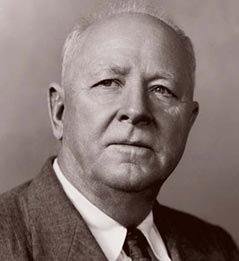15 Apr. 1881–7 July 1960

Hugh Hammond Bennett, soil conservationist, was born near Wadesboro to William Osborne and Rosa May Hammond. His father had farmed a plantation of about fifteen hundred acres from the time of the Civil War. Bennett graduated from the D. A. McGregor School in Wadesboro in 1896. After farming for one year, he entered The University of North Carolina and studied chemistry and geology. In the spring of 1899 he dropped out of the university for financial reasons and worked for two years as an apprentice in the Parsons and Hardison drug store in Wadesboro. Bennett then returned to Chapel Hill and in 1903 received a B.S. degree.
In the summer of 1903, Bennett accepted a $1,000-a-year job as a soil scientist with the Soil Survey Division of the Bureau of Soils in the U.S. Department of Agriculture. In 1909 he became inspector of soil surveys for the southern division of the bureau. Also in 1909 he was a member of an expedition to study the agricultural possibilities of the Panama Canal Zone. He traveled to make the first soil surveys of Alaska in 1914 and 1916. In 1919 he served on an international commission to settle the Nicaragua-Guatemala boundary dispute. During the winters from 1925 until 1932 he directed a soil survey of Cuba.
While making soil surveys, Bennett learned of the causes and effects of soil erosion, especially sheet erosion. Although the chief of the Bureau of Soils had written in 1909 that the "soil is the one indestructible, immutable asset that the nation possesses," Bennett became the chief advocate for measures to prevent the destruction of the soil by erosion. For years his warnings were ignored by most people. He supervised an investigation into soil erosion and moisture conservation for the Department of Agriculture's Bureau of Soils and Chemistry from 1928 to 1933. Bennett's major opportunity came in 1933, when he became director of the Soil Erosion Service in the Interior Department. A year and a half later he moved back to the Agriculture Department to head the newly created Soil Conservation Service.
Bennett wanted the Soil Conservation Service to supply the nation with scientific research, technical assistance, and leadership, but he expected the farmers to organize their own groups at the local level. He urged the states to adopt the Standard State Conservation Districts Law, which would let the farmers organize soil conservation districts at the local level, independent of the Soil Conservation Service. As director, he also worked to simplify and standardize the soil survey maps in the United States.
Known as both "the Chief" and "Big Hugh," Bennett worked continuously to spread his ideas on soil erosion and conservation. Although in many ways always a farmer from Wadesboro, Bennett had an impressive personality and an engaging speaking style that made him an effective evangelist before both farmers' groups and congressional committees. As director of the Soil Conservation Service from 1935 until his retirement in 1951, he developed the service from an idea to a government organization of thousands serving the nation's farmers. In 1953 he denounced the reorganization of the Soil Conservation Service by Secretary of Agriculture Ezra Taft Benson as a "political experiment."
Bennett received an LL.D. from The University of North Carolina in 1936, a D. Sc. from Clemson College in 1937, and a D.Sc. from Columbia University in 1952. In 1946 the governor of North Carolina declared 9 Sept. "Hugh Hammond Bennett Conservation Day in North Carolina"; on that day also the citizens of Wadesboro had a celebration in his honor. In 1947 the Department of Agriculture awarded him its first distinguished service award. The American Geographical Society presented him its Cullum gold medal in 1947. Bennett received the Izaac Walton League's highest award in 1951. Upon his retirement in 1951, the Raleigh News and Observer declared that "When history finally sets up the measure of the contribution of men in our times, it may very well be that so far as North Carolina is concerned Hugh Bennett of Wadesboro will be recognized as the most important North Carolinian of this generation."
An Episcopalian and a Democrat, Bennett also belonged to many professional organizations. He was a member of the Soil Conservation Society of America, the American Society of Agronomy, the American Geographic Society, the American Association for the Advancement of Science, the International Union for the Protection of Nature, the Association of American Geographers, the Washington Academy of Science, the Friends of the Land, the American Forestry Association, and Phi Delta Theta. He also belonged to the Cosmos Club and the Explorers.
Among Bennett's scores of articles and books are Soil Conservation (1939), Elements of Soil Conservation (1947), and The Soils and Agriculture of the Southern States (1921).
In 1907, Bennett married Sarah Edna McCue; they had a daughter, Sarah Edna. Mrs. Bennett died in 1909, and in 1921 Bennett married Betty Virginia Brown. They had one son, Hugh Hammond, Jr. For many years, while working in Washington, Bennett lived at Eight Oaks in Falls Church, Va. He died of cancer in Burlington and was buried in Arlington National Cemetery.